(Part of the Hot Spot series “By Any Media Necessary”)
By Neta Kligler-Vilenchik
(@netakv)
“Mind=blown” – this is the way that @n0anch0r, one of the participants in the “Think Critically, Act Creatively” workshop at the Digital Media & Learning (DML) Conference in Boston, described his experience. @n0anch0r wasn’t alone. @laurenthebird tweeted:
As a not-completely-objective, but still external, observer, I can only agree with their judgment. In my years of attending academic conferences, I have never seen people so enthusiastic and excited. Who would have thought what a kick a group of community organizers, educators, and academics investigating digital media would get from imagining the world in 2044, writing a scenario set in that world, and performing it in under one minute?
The “Think Critically, Act Creatively” workshop was devised by my colleagues Sangita Shresthova and Gabe Peters-Lazaro of the Media, Activism and Participatory Politics project, in collaboration with Susu Attar and Ilse Escobar, community partners, artists, and activists. The conceptualization of this workshop derives from our multi-year examination of diverse youth-driven communities which translate socially and culturally-based affinities into civic and political engagement. Groups like The Harry Potter Alliance, Nerdfighters, DREAM Activists, Libertarian Youth, and American Muslim youth, have all taught us important lessons on the role of cultural appropriation, storytelling and remixing, deploying metaphors from popular culture, and drawing on strong social ties. The workshop is an attempt to translate some of these lessons into a format that can be used in both in-school and out-of-school contexts, to reach a wide variety of youth. The goal of the workshop is to imagine a future world in which social inequality can be solved, as a way of sparking youth’s civic imagination. So far, versions of the workshop have been piloted with participants in the Muslim Youth Group Leadership Academy and with the CDF Freedom School. At DML, this was the team’s first attempt to bring the workshop to a variety of educators and academics and get their reactions (with the added challenge of conducting a workshop planned for several days over 90 minutes!). My role as supporter and live-tweeter enabled me to observe the process and share not only my impressions, but those of other participants through their tweets.
The workshop started with an icebreaker that enabled participants to immediately create media. Using Mixbit, an app for video creation, each participant was recorded expressing their one-word response to a one-word provocation. Having barely stepped into the room, participants could already see themselves on the screen along with other participants.
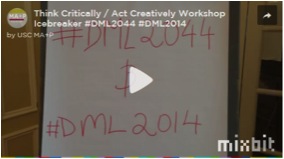
Participants were already excited about this format:

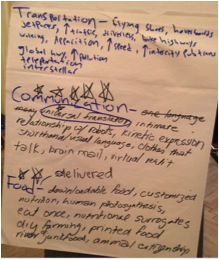 In the description of the rationale of the workshop—a world-building exercise, in which you imagine a world and find the story in it—I was particularly struck by the words of Susu Attar: “Don’t be limited by the imagination of who you are”. The first group activity was to collectively imagine the world in 2044, which is a world without borders. We brainstormed what such a world might look like, in terms of government, communication, or agriculture. Some of the ideas included: flying shoes, apparition, universal translators, intimate relationships with robots, and downloadable food.
In the description of the rationale of the workshop—a world-building exercise, in which you imagine a world and find the story in it—I was particularly struck by the words of Susu Attar: “Don’t be limited by the imagination of who you are”. The first group activity was to collectively imagine the world in 2044, which is a world without borders. We brainstormed what such a world might look like, in terms of government, communication, or agriculture. Some of the ideas included: flying shoes, apparition, universal translators, intimate relationships with robots, and downloadable food.
Next, workshop participants were divided into small groups of around five to six participants. Each group was to come up with a narrative that was set in our imaginary 2044. The groups received some creative constraints: the story should include a main character, some conflict, a pivotal moment of how this situation came to be, and a resolution. Gabe talked about the importance of creative constraints in enabling productive creativity.
After ten minutes of writing their narratives, the groups received new instructions: their stories should be performed, in any way, in under one minute. Susu explained: particularly for youth, performance helps them to break out of their shells, and say things they might not otherwise. Plus, it cracks everyone up!
And crack everyone up they did! The groups’ performances were imaginative, thought-provoking, and funny. Above all, everyone was having a blast.
After the groups’ performances, we discussed how principles of improvisational theatre are useful in thinking about digital citizenship. This was also the time for participants to share their impressions of the workshop. Quite surprisingly for the context of a conference on digital media, several participants shared how liberating it felt to put their devices aside and to connect with each other on an interpersonal level. Another participant shared the excitement his group felt – like a bunch of kids – and pondered on how impactful creativity can be. Many of the educators and organizers in the room were already devising ways of bringing this activity “to the youth back home”.
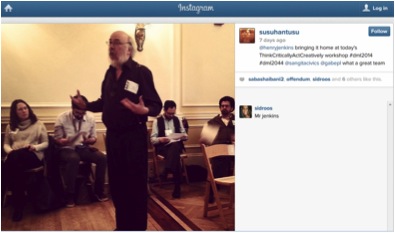
In the wrap-up to the workshop, Henry Jenkins linked us back to the idea of the civic imagination. The workshop, he explained, is an exercise in critical utopianism – imagining what the world could be like, examining where we are now, and then devising the steps that take us from here to there.
As for me, I can only thank the workshop organizers and all the participants for such an electrifying experience. #DML 2044, coming soon to a youth space near you!
And… long live the Lasagna Revolution!
…Check out all tweets coming out of the workshop – #DML2044…




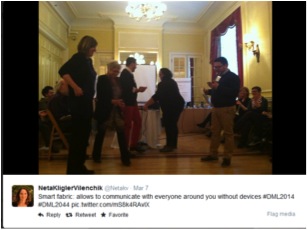
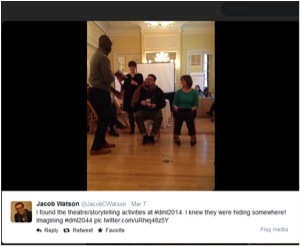


Speak Your Mind